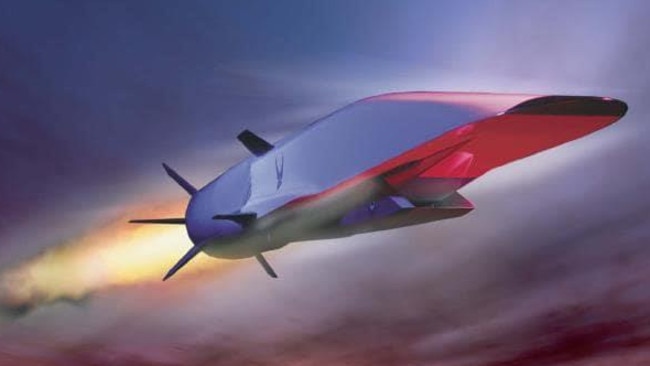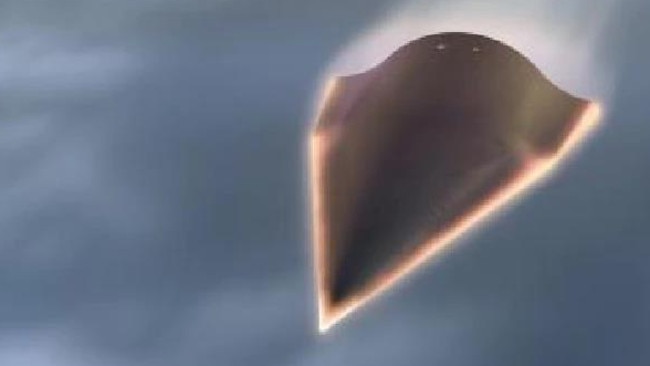Inside the terrifying global arms race for hypersonic weapons
THE biggest militaries in the world are racing towards a new type of missile which can travel at five times the speed of sound and penetrate most defences.

THE latest global arms race has gone hypersonic.
Capable of flying faster than 5000km/h without losing manoeuvrability and lower in the atmosphere than traditional ballistic missiles, hypersonic weapons will offer clear advantages in penetrating missile defences — once they’ve actually been perfected.
Though still in development by nations around the world, once fully operational, the missiles are expected to be capable of destroying targets anywhere on the planet within an hour of getting data and permission to launch.
The weapons will also lessen the timelines for a response by a nation under attack.
The technology, as deadly as it is troubling, was the focus of a recent report which recommended “the United States, Russia, and China should agree not to export complete hypersonic missile systems or their major components”.
The warning appears to have fallen on deaf ears, however, with all three superpowers being vocal about the ongoing development of these weapons.
However, it’s not just the US, China and Russia in pursuit of creating a battle-capable hypersonic missile. France, India and Australia among others are also in the race.
A HISTORY OF FAILURE
Building a hypersonic weapon was never going to be easy. Each of the three superpowers have had public failures during development stages over recent years.
The US has been testing the technology since 2010, with the most high-profile failure coming in 2014 when a hypersonic weapon was destroyed four seconds after its test launch due to a problem detected with the system.
Similarly, China has suffered a number of setbacks dating to January 2014. Its second hypersonic glide vehicle (HGV) test attracted attention as it was the only one that had public images of its components.
Russia has also been prolific in testing, with five recorded failures between December 2011 and April 2016.

THE CHALLENGES
The biggest problem with the development of hypersonic weapons is learning how the interconnected metal and electronics behave when moving at such fast speeds.
Chief of staff for defence at the military’s High Performance Computing Modernisation program Kevin Newmeyer said supercomputers were needed to calculate how air and solid surfaces would interact.
“Instead of modelling a single aircraft, you have to model the surface and air in blocks as small as centimetres, millimetres. You join these calculations together in a cascading set of calculations,” he told Defense One.
US Defence Advanced Research Projects Agency (DARPA) director Steven Walker said while supercomputers will ultimately help the development, physical testing is going to be needed to ensure the calculations are more than just guesses.
“Another complicating factor in hypersonics is you can only simulate so much on the ground. It’s hard to get the velocity, the temperature, the mach number (speed) all correct as the vehicle would experience [them] in the air,” he said.
“We do component testing on the ground. We’ll do this engine testing on the ground. With hypersonics, you really have to fly.”
HOW CLOSE IS CHINA?
China’s military has been testing the DF-17 — a ballistic missile combined with a hypersonic glide vehicle (HGV).
An anonymous US government source told The Diplomat magazine the weapon was tested on two different occasions.
In one of the tests, the missile’s payload flew to a range of approximately 1400km, with the source saying the missile successfully made impact at a site in Xinjiang Province “within metres” of the intended target.
As HGVs stop short of entering space and they shoot down to Earth at hypersonic speeds, they pose challenges for early-warning satellites and missile-defence systems.
According to US intelligence assessments, the DF-17 is expected to reach initial operating capability by around 2020, with the weapon expected to be capable of delivering both nuclear and conventional warheads.
HOW CLOSE IS RUSSIA?
Ðа боевое дежурÑтво поÑтавлен новейший гиперзвуковой ÐºÐ¾Ð¼Ð¿Ð»ÐµÐºÑ Â«ÐšÐ¸Ð½Ð¶Ð°Ð»Â» https://t.co/GCc57s3T36 pic.twitter.com/nKCzlXDHLW
— Телеканал "Звезда" (@zvezdanews) March 1, 2018
Putin claims to have a hypersonic glide vehicle known as Avangard.
It is possible this hypersonic glide vehicle was tested in September last year when it launched a RS-12M Topol ballistic missile with what it vaguely described as an “advanced combat payload”.
Putin also claims to have the ultimate long-range ‘stand-off’ weapon, which he calls “Kinzhal”.
This hypervelocity guided missile can be steered, is capable of being carried by combat jets, has a range of 2000km and top speed at 10 times the speed of sound.
It’s supposed to have already been deployed to frontline military units.
Supporting this was video footage of an old Mig-31 “Foxhound” high-speed interceptor aircraft carrying a tubby bullet-shaped weapon.
HOW CLOSE IS THE US?
The US has been developing hypersonic missiles around the clock at NASA’s Langley Research Centre in Virginia, with two weapon concepts in the works.
Firstly there is a Tactical Boost Glide weapon — a system that operates at five times the speed of sound and offers military operations longer ranges with shorter response times.
Essentially a rocket accelerates its payload to high speeds, then separates and allows it to glide unpowered to its target destination.
The second project is the hypersonic air-breathing weapon concept (HAWC) which uses the technology of a scramjet engine — enabling hypersonic flight by taking in air at supersonic speeds and burning it without reducing it to below the speed of sound.
In its 2019 budget request, DARPA asked for $A330 million in funding for continued hypersonic research.
Of this amount, $A18.4 million would be put towards the HAWC project, while $A179.5 million would be for the Tactical Boost Glide program — both hope to have an operational prototype by 2019 and 2022, respectively.
Another $A64.3 million has also been requested to develop a ground-launched hypersonic system based on similar technology used in the Tactical Boost Glide program.
Additionally, DARPA got $A68.2 million for the Advanced Full Range Engine program, which hopes to create a hybrid engine that combines a traditional off-the-shelf turbine engine capable of supersonic speed with a dual-mode ramjet to transition to hypersonic flight.

HOW CLOSE IS AUSTRALIA?
Australia has previously conducted a set of test flights of a missile capable of burning through the skies at more than 10,000km/h.
In 2017, Defence Minister Marise Payne released a statement which said the $54 million Hypersonic International Flight Research Experimentation (HIFiRE) tests were recently wrapped up in the skies above the remote South Australian town of Woomera.
Australia and the United States have been working in partnership on hypervelocity flight for almost a decade. The first launch of one of its test vehicles was conducted in 2009, with subsequent tests in 2012 and 2016.
Top speeds obtained have reportedly been as high as 9878km/h, but controlled hypersonic flight has proven to be a serious challenge.
Overcoming the issues have required advances in the propulsion systems, the strength of airframes, heat-resistant materials and refining aerodynamics and creating AI-controlled avionics both fast and subtle enough to direct a craft hurtling at such immense speeds.
“While this (HIFiRE 4) is the last in the HIFiRE series, Australia remains at the leading edge of hypersonics research, test and evaluation, thanks to the work of this dedicated team of defence scientists and their industry and academic partners,” Ms Payne said.
WHAT ABOUT EVERYONE ELSE?
The Defence Research & Development Organisation (DRDO) of India has been developing hypersonic weapons from as far back as 2004.
India has already managed to successfully test-fire BrahMos supersonic cruise missile — which travels at three times the speed of sound — from a Sukhoi-30MKI fighter jet last year.
The country is believed to be working on a hypersonic variant of the missile which will use a scramjet engine with special fuel to reach speeds of more than 5000km/h.
France is also currently developing hypersonic cruise missile technology for use in an air-to-surface nuclear weapon delivery vehicle dubbed the ASN4G.
The Japanese Aerospace Exploration Agency is also developing hypersonic capabilities, but only for “commercial flights”.
Continue the conversation in the comments below or with Matthew Dunn on Facebook and Twitter.



